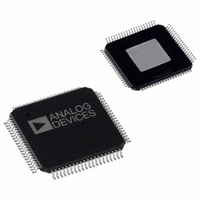AD9775BSVRL Analog Devices Inc, AD9775BSVRL Datasheet - Page 25

AD9775BSVRL
Manufacturer Part Number
AD9775BSVRL
Description
IC DAC 14BIT DUAL 160MSPS 80TQFP
Manufacturer
Analog Devices Inc
Series
TxDAC+®r
Datasheet
1.AD9775BSVZRL.pdf
(56 pages)
Specifications of AD9775BSVRL
Rohs Status
RoHS non-compliant
Settling Time
11ns
Number Of Bits
14
Data Interface
Parallel
Number Of Converters
2
Voltage Supply Source
Analog and Digital
Power Dissipation (max)
410mW
Operating Temperature
-40°C ~ 85°C
Mounting Type
Surface Mount
Package / Case
80-TQFP Exposed Pad, 80-eTQFP, 80-HTQFP, 80-VQFP
For Use With
AD9775-EBZ - BOARD EVALUATION FOR AD9775
The offset control defines a small current that can be added to
I
of which I
via Register 0x08, Bit 7 (IDAC) and Register 0x0C, Bit 7 (QDAC).
Figure 41 shows the scale of the offset current that can be added
to one of the complementary outputs on the IDAC and QDAC.
Offset control can be used for suppression of LO leakage resulting
from modulation of dc signal components. If the AD9775 is dc-
coupled to an external modulator, this feature can be used to
cancel the output offset on the AD9775 as well as the input offset
on the modulator. Figure 42 shows a typical example of the effect
that the offset control has on LO suppression.
In Figure 42, the negative scale represents an offset added to I
while the positive scale represents an offset added to I
respective DAC. Offset Register 1 corresponds to IDAC, while
Offset Register 2 corresponds to QDAC. Figure 42 represents the
AD9775 synthesizing a complex signal that is then dc-coupled to
an AD8345 quadrature modulator with an LO of 800 MHz. The
dc coupling allows the input offset of the AD8345 to be calibrated
out as well. The LO suppression at the AD8345 output was opti-
mized first by adjusting Offset Register 1 in the AD9775. When
an optimal point was found (roughly Code 54), this code was
held in Offset Register 1, and Offset Register 2 was adjusted. The
resulting LO suppression is 70 dBFS. These are typical numbers;
the specific code for optimization varies from part to part.
1R/2R MODE
In 2R mode, the reference current for each channel is set
independently by the FSADJ resistor on that channel. The
AD9775 can be programmed to derive its reference current
from a single resistor on Pin 60 by placing the part into 1R
mode. The transfer functions in Equation 1 are valid for 2R
mode. In 1R mode, the current developed in the single FSADJ
resistor is split equally between the two channels. The result is
that in 1R mode, a scale factor of 1/2 must be applied to the
formulas in Equation 1. The full-scale DAC current in 1R mode
can still be set to as high as 20 mA by using the internal 1.2 V
reference and a 950 Ω resistor instead of the 1.9 kΩ resistor
typically used in the 2R mode.
OUTA
or I
5
4
3
2
1
0
OUTB
0
0
OUT
(not both) on the IDAC and QDAC. The selection
this offset current is directed toward is programmable
200
Figure 41. DAC Output Offset Current
(ASSUMING RSET1, RSET2 = 1.9kΩ)
COARSE GAIN REGISTER CODE
400
600
2R MODE
800
1R MODE
1000
OUTA
of the
OUTB
Rev. E | Page 25 of 56
,
CLOCK INPUT CONFIGURATIONS
The clock inputs to the AD9775 can be driven differentially
or single-ended. The internal clock circuitry has supply and
ground (CLKVDD, CLKGND) separate from the other supplies
on the chip to minimize jitter from internal noise sources.
Figure 43 shows the AD9775 driven from a single-ended
clock source. The CLK+/CLK− pins form a differential input
(CLKIN) so that the statically terminated input must be dc-
biased to the midswing voltage level of the clock driven input.
A configuration for differentially driving the clock inputs is
given in Figure 44. DC-blocking capacitors can be used to
couple a clock driver output whose voltage swings exceed
CLKVDD or CLKGND. If the driver voltage swings are within
the supply range of the AD9775, the dc-blocking capacitors and
bias resistors are not necessary.
–10
–20
–30
–40
–50
–60
–70
–80
–1024
0
Figure 42. Offset Adjust Control, Effect on LO Suppression
Figure 43. Single-Ended Clock Driving Clock Inputs
Figure 44. Differential Clock Driving Clock Inputs
–768
ECL/PECL
V
THRESHOLD
DAC1, DAC2 (OFFSET REGISTER CODES)
AD9775
–512
0.1μF
0.1μF
0.1μF
–256
AD9775
OFFSET REGISTER 1 ADJUSTED
R
0.1μF
SERIES
0
1kΩ
1kΩ
1kΩ
1kΩ
OFFSET REGISTER 2
ADJUSTED, WITH OFFSET
REGISTER 1 SET
TO OPTIMIZED VALUE
256
CLK+
CLKVDD
CLK–
CLKGND
CLK+
CLKVDD
CLK–
CLKGND
512
768
AD9775
1024












